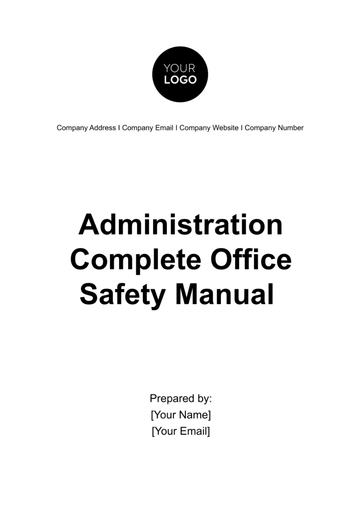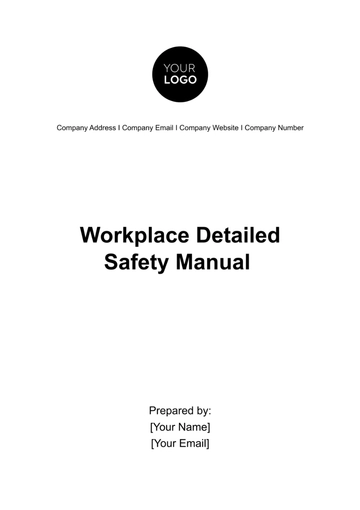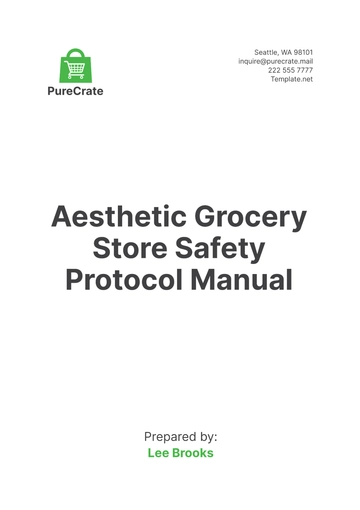Free Workplace Detailed Safety Manual

I. Introduction and Purpose
This manual serves as a guide to foster a culture of safety and awareness within our organization. It outlines the necessary procedures, responsibilities, and actions to prevent and address potential workplace hazards. By adhering to these guidelines, we aim to protect the well-being of our employees, contractors, and visitors, while maintaining compliance with regulatory requirements. Embrace this manual as a tool for a safer workplace.
II. Company Policy on Health and Safety
[Your Company Name] is steadfast in its commitment to maintaining the highest standards of health and safety in our workplace. Our policy is designed to foster a culture of safety and well-being among all employees and visitors.
Commitment to Safety: We are dedicated to providing a safe work environment. This involves regular risk assessments, implementing necessary safety measures, and providing ongoing training to our employees.
Compliance with Regulations: Adhering to all federal, state, and local safety regulations is not just a legal obligation but a moral one. We stay updated on the latest standards to ensure our practices meet or exceed legal requirements.
Employee Responsibility: Safety is a collective responsibility. All employees are required to follow safety procedures, report hazards, and participate in safety training sessions.
Incident Reporting and Investigation: Any incidents or near misses must be promptly reported to the appropriate supervisor. Thorough investigations will be conducted to understand the cause and to prevent future occurrences.
Health and Safety Training: Regular training sessions will be provided to all employees to educate them about safety practices, emergency procedures, and health risks related to their specific roles.
Continuous Improvement: We believe in the continual improvement of our health and safety practices. Feedback from employees is encouraged and will be used to enhance our safety protocols.
Emergency Preparedness: Effective plans for emergency situations, including evacuations and first aid, are in place and are regularly reviewed.
III. Risk Assessment and Management
To ensure a safe workplace, [Your Company Name] adopts a systematic approach to risk assessment and management. Following these steps diligently will help identify, evaluate, and mitigate potential hazards, upholding our commitment to health and safety.
IV. Emergency Procedures
In the interest of safety, [Your Company Name] has established a structured emergency procedure. This protocol is designed to effectively manage unforeseen situations, ensuring the protection and swift response for all employees and visitors during emergencies.
Emergency Procedures
Alarm and Alert: In the event of an emergency, immediately activate the nearest alarm system and alert fellow employees and emergency services if necessary.
Evacuation Plan: Follow the predetermined evacuation routes displayed throughout the facility. Evacuate calmly and quickly to the designated assembly area.
Assistance to Others: Assist any colleagues who may require help in evacuating, keeping in mind your own safety.
Headcount and Reporting: Once at the assembly area, supervisors should perform a headcount and report any missing persons to emergency responders.
Emergency Services Coordination: Cooperate with arriving emergency services and follow their instructions. Provide them with any necessary information about the situation.
Post-Emergency Briefing: After the emergency, participate in a briefing to discuss the response and any improvements that can be made to the emergency procedures.
Following these steps will help ensure a coordinated and effective response in case of an emergency at [Your Company Name].
V. Equipment Safety
At [Your Company Name], ensuring the safe operation and maintenance of all equipment is a top priority. Our equipment safety procedures are designed to protect employees and prevent workplace accidents.
Here are our guidelines to maintaining a safe working environment and minimizing the risks associated with equipment operation:
|
|
VI. Hazardous Materials Handling
At [Your Company Name], handling hazardous materials is a critical task requiring meticulous attention to safety protocols. Our comprehensive approach includes:
Identification and Labeling: All hazardous materials must be clearly identified and labeled according to OSHA guidelines.
Proper Storage: Store hazardous materials in designated areas, equipped with appropriate containment measures to prevent spills or leaks.
Handling and Usage Procedures: Employees must follow specific procedures for safe handling and use of hazardous materials, including the use of PPE.
Spill Response: Implement and practice a spill response plan, detailing steps to contain and clean up spills safely.
Disposal: Ensure the proper and legal disposal of hazardous materials in accordance with environmental regulations.
Training: Provide regular training to employees on handling hazardous materials, including emergency response and safety measures.
VII. Health and Safety Training
Effective health and safety training at [Your Company Name] encompasses several key areas:
Initial Orientation: New employees receive comprehensive orientation covering basic safety policies, emergency procedures, and their specific job-related hazards.
Ongoing Training Programs: Regular training sessions are conducted to refresh and update employees on safety procedures and changes in regulations.
Specialized Training for Specific Roles: Employees handling specialized tasks or hazardous materials receive additional, role-specific safety training.
Record-Keeping: Detailed records of all training sessions, participants, and topics covered are maintained for compliance and reference purposes.
Continuous Improvement: Training programs are regularly reviewed and updated based on new safety information, incident analyses, and employee feedback, ensuring ongoing improvement in safety practices.
These components work together to ensure a well-informed and safe workforce.
VIII. Personal Protective Equipment (PPE)
[Your Company Name] is committed to the safety of all employees, and Personal Protective Equipment (PPE) plays a critical role in this commitment. We ensure that appropriate PPE is provided for various job functions, including helmets, goggles, gloves, and protective clothing, as necessary. Employees are trained in the correct use and maintenance of these items. Regular assessments are conducted to keep our PPE policy updated with evolving safety standards and technological advancements, guaranteeing the highest level of protection in our workplace.
IX. Incident Reporting and Investigation
We prioritize a thorough and systematic approach to incident reporting and investigation. This process is integral to our commitment to maintaining a safe and responsible work environment. It allows us to identify root causes, implement corrective measures, and prevent future occurrences.
Understanding that each incident offers an opportunity for learning and improvement, we have developed a comprehensive and detailed methodology. This ensures every incident is handled with the utmost diligence, contributing to our ongoing mission of enhancing workplace safety and employee well-being.
X. Workplace Ergonomics
At [Your Company Name], we recognize the importance of workplace ergonomics in ensuring employee health and productivity. Our ergonomic strategy includes the following key areas:
Ergonomic Assessment: Regular assessments of workstations are conducted to identify potential ergonomic risks and to ensure that the setup supports the employee’s posture, comfort, and efficiency.
Equipment and Furniture: We provide ergonomic furniture and equipment, such as adjustable chairs, desks, and keyboard trays, to reduce strain and enhance comfort.
Employee Training: Employees receive training on proper ergonomic practices, including correct posture, equipment usage, and stretching exercises.
Regular Breaks: Encouraging regular breaks to reduce physical and eye strain, especially for employees in sedentary or repetitive jobs.
Continuous Improvement: Regularly reviewing and updating ergonomic practices based on employee feedback and new research findings in ergonomics.
Through these measures, [Your Company Name] aims to create a comfortable and sustainable work environment that minimizes risk and promotes employee well-being.
XI. Regular Safety Audits and Inspections
At [Your Company Name], regular safety audits and inspections are a cornerstone of our commitment to a safe working environment. This process is structured into several key areas:
Scheduled Audits: Conducting comprehensive safety audits at regular intervals to assess compliance with safety standards and identify potential risks.
Unscheduled Inspections: Random, unscheduled inspections to ensure ongoing adherence to safety protocols and to identify any immediate hazards.
Equipment Checks: Regular examination of machinery and equipment to ensure they are in good working order and meet safety standards.
Environmental Assessments: Evaluating the workplace environment for factors such as air quality, noise levels, and lighting to ensure they meet health and safety guidelines.
Employee Feedback: Actively involving employees in safety audits and inspections, considering their insights and concerns.
Audit Reporting and Action Plans: Documenting findings from audits and inspections and developing action plans to address any identified issues.
XII. Compliance with Legal and Regulatory Requirements
At [Your Company Name], strict adherence to legal and regulatory requirements in health and safety is fundamental to our operations. Our approach includes several key components:
Regulatory Monitoring: Keeping abreast of current federal, state, and local health and safety regulations to ensure full compliance.
Policy Alignment: Regularly updating our internal safety policies to align with the latest legal standards and best practices.
Employee Training: Conducting ongoing training sessions for employees to educate them on legal requirements and their role in compliance.
Documentation and Record Keeping: Meticulously documenting safety procedures, incidents, and compliance efforts to provide transparency and accountability.
Audits and Reviews: Implementing internal and external audits to review and assess compliance with regulatory requirements.
Continuous Improvement: Actively seeking ways to go beyond mere compliance, aiming for excellence in health and safety standards.
This structured approach ensures that [Your Company Name] not only complies with all legal obligations but also fosters a culture of safety and responsibility throughout the organization.
XIII. Responsibilities and Enforcement
At [Your Company Name], clear delineation of responsibilities and robust enforcement mechanisms are key to our health and safety management. Our structure includes:
Section | Responsibilities and Tasks |
Management |
|
Employees |
|
Safety Officer |
|
Enforcement Policies |
|
Regular Reviews |
|
Feedback Mechanism |
|
- 100% Customizable, free editor
- Access 1 Million+ Templates, photo’s & graphics
- Download or share as a template
- Click and replace photos, graphics, text, backgrounds
- Resize, crop, AI write & more
- Access advanced editor
Elevate workplace safety standards with Template.net's Workplace Detailed Safety Manual Template. This editable and customizable template, coupled with our advanced Ai Editor Tool, offers a seamless experience in crafting comprehensive safety manuals. Ensure compliance and mitigate risks effectively with this essential resource from Template.net.





























